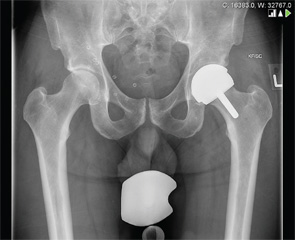
Hip-resurfacing (HR) arthroplasty is a procedure that preserves bone and allows patients to return to a higher level of function with a longer prosthesis life compared with patients who receive a total hip arthroplasty (THA).1 It’s considered an alternative to THA in a select group of patients who might potentially outlive a THA.1
During HR, the femoral neck is preserved, and the femoral head is shaped and capped with a metal device and short stem. The acetabulum is also lined with a specific metal device.2 There are several types of hip-resurfacing systems.
The U.S. Food and Drug Administration (FDA) has approved three metal-on-metal (MoM) hip-resurfacing systems in the U.S.: the Birmingham (BHR), the Cormet and the Conserve-Plus hip-resurfacing systems.3 The ideal candidate for the BHR system is an active male, younger than 65 years old, with osteoarthritis and relatively normal bone morphology who has not improved with conservative treatment.4
Contraindications to HR include being female of childbearing age, osteonecrosis involving more than 50% of the femoral head, impaired renal function, severe osteoporosis and known metal sensitivity.4
Case Description
The patient was a 55-year-old male who presented to physical therapy (PT) with a chief complaint of progressively worsening left hip pain for 20 months. He reported left groin and posterolateral deep hip pain that was exacerbated by prolonged walking, sitting, running, squatting, pivoting off the left leg, descending stairs and activities of daily living (ADLs). He reported that pain improved with stretching, ice, use of ibuprofen or acetaminophen and non-weight-bearing exercise. The patient’s goals were to decrease pain, improve function and return to daily running, exercise and strength training.
On examination, the patient had a mild antalgic gait, positive left hip scour test, positive anterior pelvic tilt, decreased left hip strength and range of motion and decreased joint play. The hypothesized underlying condition was left hip osteoarthritis. The patient’s preoperative PT consisted of passive hip range of motion, muscle energy techniques, hip mobilization, including long axis and lateral distraction, progressive therapeutic strengthening and a stretching program. Electrical stimulation and ice were used as an adjunct for pain relief.
The patient did not improve significantly with skilled PT and was referred to an orthopedic surgeon. Radiographs (see Figure 1) showed osteoarthritis of the acetabulum and femoral head, decreased joint space and osteophyte formation on the acetabular rim. Surgical options for the patient included HR or a THA.
Due to the patient’s age, physical fitness and activity, good bone density and goal of returning to sports and high-level activities, such as running, he was determined to be a good candidate for HR.
The patient underwent resurfacing of the acetabulum and femoral head two months later. The patient in this case had a posterolateral approach, and the surgeon used the Birmingham hip resurfacing system (see Figure 2).


Outcomes
The patient received short-term home PT following surgery. Home PT focused on improving function within the home, as well as improvement of hip motion and increasing strength. The patient was avid about completing his strengthening and stretching therapeutic exercises. In addition, the patient invested in a recumbent bike and used it six days a week to help improve his hip ROM and maintain cardiovascular fitness.
Following home PT, the patient completed two months of outpatient PT. On examination, the patient had moderate pain levels with activity, a positive antalgic gait, moderate soft tissue restrictions, 105° of hip flexion and 0° of hip extension. The patient’s goals were to walk without pain and, eventually, to return to high-level activities, such as running, road biking and weight lifting. The patient’s PT goals included decreasing pain, improving ROM, increasing strength, normalizing gait and returning to his premorbid level of function. The patient’s outpatient PT consisted of progressive therapeutic strengthening and stretching, soft tissue and scar mobilization, and aerobic conditioning on a stationary bike. He was discharged with 120° left hip flexion and left hip strength of 4+/5. He had no pain during ADLs and was able to gradually progress to running independently without pain or gait deviation.
At a four-year postoperative follow-up, he reported no hip pain during ADLs, elliptical or weight training, or using free and machine weights. The patient had recently completed a 5 km race with a time of 33 minutes, without hip pain. He was very satisfied with his postoperative function and activity levels.
Discussion
HR is an alternative to THA for a select group of patients.1 With appropriate postoperative rehabilitation, this procedure allows younger, more active patients to return to athletic activities and high-impact sports.5 THA and HR differ in the amount of bone removed and the amount of joint stability following the procedure.
In an HR procedure, the femoral neck is preserved, allowing patients the potential to return to high-level activity due to intrinsic bone stability.1 In addition, the bone conservation of the femoral neck allows conversion to THA when indicated in aging patients.6 HR restores physiologic motion and normal gait and has a greater likelihood of maintaining normal leg length compared to THA.6,7
In comparison, THA requires resection of the femoral neck, making the hip more susceptible to dislocation postoperatively. However, HR is a more technically demanding surgical procedure than THA and typically requires a larger incision than THA.6
Current research indicates that patients post-HR benefit from a more dynamic tailored rehabilitation program compared with a traditional THA approach.2,8 It’s important for physical therapists working with this patient population to be familiar with outcomes and prognosis following this procedure, as well as complications, such as femoral neck fractures.2 Femoral neck fractures typically occur early in the postoperative rehabilitation and are more common in women.9 An incidence of 1.46% has been reported.9
THA & HR differ in the amount of bone removed & the amount of joint stability following the procedure.
Rates of groin pain postoperatively have been reported to be as high as 18%, and causes include hip impingement, component malpositioning, iliopsoas tendinopathy and adverse soft-tissue reactions.10 Facilitation of good recruitment of lumbopelvic muscles and avoiding overuse of the psoas major muscle postoperatively are important to help prevent iliopsoas pathology.2 Adverse soft tissue reactions may be due to sensitivity to wear particles from MoM chromium and cobalt implant components.10
Other postoperative complications include prosthetic loosening and heterotrophic ossification.9
Current research indicates that returning to running is possible after HR; however, long-term follow-up is required to assess the impact of running and other high-impact activities on the prosthetic components, loosening and revision rates.11 Patients who have undergone HR have a high rate of return to sport and have been able to return to recreational sports without restrictions.5,12
In comparison, return to high-impact sport after THA has been associated with increased wear and mechanical failure of the implant.13 Patients with THA are more likely to discontinue high-impact activities and shift to low-impact activities, such as exercise walking.14
Following HR, patients have reported improved quality of life and a high rate of satisfaction with their outcome.15 The medium-term outcomes, up to 13 years postoperatively, for patients following HR with a BHR are very favorable.1
Research Needed
Further research is needed to investigate the long-term outcomes of high-functioning patients following HR and to investigate any potential long-term risk of adverse metal hypersensitivity reactions associated with MoM articulations.

Caitlyn M. Beltrani, PT, DPT, received a clinical doctorate in Physical Therapy from Northeastern University in 2014. Caitlyn is passionate about orthopedic sports medicine and rehabilitating athletes of all ages.

Marie B. Corkery, PT, DPT, MHS, FAAOMPT, is an associate clinical professor in the Department of Physical Therapy, Movement and Rehabilitation Sciences, Northeastern University, Boston.
References
- McMinn DJ, Daniel J, Ziaee H, et al. Indications and results of hip resurfacing. Int Orthop. 2011;35(2):231–237.
- Siverling S, Felix I, Chow SB, et al. Hip resurfacing: Not your average hip replacement. Curr Rev Musculoskelet Med. 2012;5(1):32–38.
- U.S. Food and Drug Administration. Metal-on-metal hip implant systems. 2013 Jan 17; http://www.fda.gov/MedicalDevices/ProductsandMedicalProcedures/ImplantsandProsthetics/MetalonMetalHipImplants/ucm241601.htm.
- Nunley RM, Della Valle CJ, Barrack RL. Is patient selection important for hip resurfacing? Clin Orthop Relat Res. 2009;467(1):56–65.
- Fisher NE, Killampalli VV, Kundra RK, et al. Sporting and physical activity following hip resurfacing. Int Orthop. 2011;35(7):977–980.
- Quesada MJ, Marker DR, Mont MA. Metal-on-metal hip resurfacing: Advantages and disadvantages. J Arthroplasty. 2008 Oct;23(7 Suppl):69–73.
- Brown NM, Foran JRH, Della Valle CJ. Hip resurfacing and conventional THA: Comparison of acetabular bone stock removal, leg length, and offset. Orthopedics. 2013 May;36(5):e637–e641.
- Barker KL, Newman MA, Hughes T, et al. Recovery of function following hip resurfacing arthroplasty: A randomized controlled trial comparing an accelerated versus standard physiotherapy rehabilitation programme. Clin Rehabil. 2013 Sep;27(9):771–784.
- Shimmin AJ, Bare J, Back DL. Complications associated with hip resurfacing arthroplasty. Orthop Clin North Am. 2005 Apr;36(2):187–193, ix.
- Bin Nasser A, Beaulé PE, O’Neill M, et al. Incidence of groin pain after metal-on-metal hip resurfacing. Clin Orthop Relat Res. 2010;468(2):392–399.
- Fouilleron N, Wavreille G, Endjah N, et al. Running activity after hip resurfacing arthroplasty: A prospective study. Am J Sports Med. 2012 Apr;40(4):889–894.
- Girard J, Miletic B, Deny A, et al. Can patients return to high-impact physical activities after hip resurfacing? A prospective study. Int Orthop. 2013;37(6):1019–1024.
- Ollivier M, Frey S, Parratte S, et al. Does impact sport activity influence total hip arthroplasty durability? Clin Orthop Relat Res. 2012;470(11):3060–3066.
- Chatterji UC, Ashworth MJ, Lewis PL, et al. Effect of total hip arthroplasty on recreational and sporting activity. Total Hip Arthroplast Sport. 2004;74:446–449.
- Rahman WA, Greidanus NV, Siegmeth A, et al. Patients report improvement in quality of life and satisfaction after hip resurfacing arthroplasty. Clin Orthop Relat Res. 2013;471(2):444–453.

